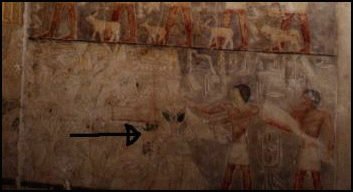
© Photo copyright Cosmic Conspiracies
The following is from an actual Internet website (to view the original from Cosmic Conspiracies, click here). There are many such sites on the Internet that make claims that are quite extraordinary. How sound are these claims? Using your good judgment and keen sense of logic, see if you can detect what is wrong:

© Photo copyright Cosmic Conspiracies
Cosmic Conspiracies were recently searching the web for pictures of ancient Egypt for a forthcoming T Shirt project for this site. Whilst we were visiting various Egyptology sites we came across this picture that was taken inside the Tomb of Ptah-Hotep, at Saqqara, Egypt, which dates back to the 5th Dynasty. The picture shows servants offering food to the Egyptian sage and Philosopher Ptah-Hotep (who is sat at a table to the left of this part of the picture). Ptah-hotep served during the reign of Izezi as a sage. His maxims are in the Prisse Papyrus which are in the Louvre. Izezi was the eighth king of the 5th Dynasty and ruled Egypt from 2388 till 2356 BC.
We were flabbergasted to say the least when we took a closer look at this image and could make out an 'alien grey' in the bottom of the picture! Does this prove that the building and placement of the Pyramids were aided by alien intelligence?
We have only been able to find the three images of this picture that you see here and have learned that this particular wall mural does not appear in any official guidebooks!... I wonder why? I have found out however that a picture showing this same mural is in an old book called 'In The Shadow Of The Pyramids - Egypt during the Old Kingdom'.
The implications of the discovery of this ancient stone picture that includes the alien are absolutely huge! and could be one of the most important clues to alien intervention into our ancient history ever made!
Enlargement.
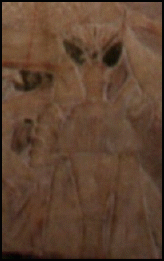
© Photo copyright Cosmic Conspiracies
Here is an enlargement of 'The Grey'. This picture could explain why the Egyptians appeared to be so technically advanced, and how they were able to build the Pyramids with such precision. For instance the coffin in The Great Pyramid was cut so accurately that we could not even recreate a similar coffin out of rock today - even with our laser technology!
© Copyright Cosmic Conspiracies.
Face it, great discoveries have been made while looking for a good T-shirt design, and there are likely plenty of earth-shaking revelations to be found while excavating the Internet. But is this "alien grey" one of them? The most striking feature of this website is the poor quality of the photographs. They are blurry and murky, and details are difficult to distinguish. The figure identified as the "alien grey" is of an ambiguous shape, but it does look like there might be eyes, and perhaps a frowning mouth, and possibly arms folded upon the chest, as if in a rather cross demeanor. But this is a subjective interpretation, much as one might describe the shape of an ink-blot, and it is helped along by the suggestion of the authors. The text informs us that "the picture shows servants offering food" to Ptah-Hotep, the owner of the tomb in which the relief is found. One might well wonder at the presence of an alien among a collection of food offerings. It is also notable that if the figure is indeed an alien, it is shown in a frontal view -- face on -- quite unlike the other figure in the scene and, indeed, quite unlike Egyptian artistic conventions in general.
While the figure might bear some similarity to what we today think extraterrestrial beings look like, an open mind would reserve judgment until better quality photographs could be examined, as photographic evidence appears to be the single basis of the authors' theory. As it turns out, those authors might well hope that you do not have the resources to try to find them, and as a further discouragement they cite an "old book," In the Shadow of the Pyramids. Neither the author nor the date is cited. Fortunately, it is not hard to find information about a book from its title, and one needn't go to too much trouble to find that the author is Jaromír Málek, and that the book was first published in 1986 (it isn't all that old, after all, but it is out of print).
The authors of the website claim to "have only been able to find the three images of this picture that you see here and have learned that this particular wall mural does not appear in any official guidebooks!... I wonder why?" The implication is that there is some conspiracy afoot trying to suppress the "absolutely huge" implications of this tomb relief. Is it such a secret? A look in any general tourist guidebook to Egypt reveals that "the double mastaba of Akhti-Hotep and Ptah-Hotep" is open to visitors (and photographs may be made if a flash is not used). If the relief is a secret, it doesn't seem to be a very well-kept one.
Indeed, luckily for the casual visitor to Egypt, Bonechi's All of Egypt, a glossy tourist photo paperback hawked by vendors at popular sites throughout the country, has a picture of this very relief on page 45:
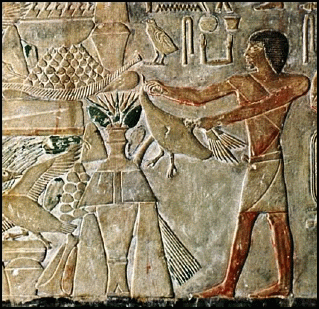
© Photo copyright Bonechi
Seen more clearly, the little "alien grey" takes on quite a different perspective. The figure looked much more alien-like in the fuzzy picture, but here it looks rather like something else altogether. But what is it?
Detail
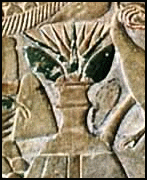
© Photo copyright Bonechi
What before looked like a mouth now looks like the neck of a bottle, perhaps, and the head doesn't look like a head at all, but more like a flower or some plant-like thing, sprouting spiny projections. The "eyes" here no longer resemble eyes. What is this thing? Recall that the context in which this relief is found is that of an offering scene. Might this be an offering of some plant, perhaps a flower? Consulting a general reference on ancient Egyptian culture, and looking specifically for flowers, it could be found that the lotus represents Upper Egypt and also is symbolic of rebirth. This seems a reasonable image to be found in a tomb. Further, a casual library researcher would discover that there are two types of lotus, one with "pointed buds and petals." This seems to better describe the mysterious figure than its being in the likeness of an alien from some other planet.
It seems much more logical to suppose that the peculiar figure pictured is the image of a lotus blossom, with a bud on each side of it, placed in a vase or jar as an offering. Is it possible to confirm this alternate theory? Another relief in the same tomb depicts a man gathering lotus blossoms as he places them in a basket:
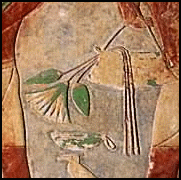
© Photo copyright Alberto Siliotti
Clearly, we may now say that what looked like eyes were in reality flower buds, and what in a very poor photograph looked something like an "alien grey" looks exactly like that which it was meant to represent: An offering of a lotus blossom.
This particular exercise was fairly easy, especially with an elementary knowledge of Egyptian art and a few references at hand. The following (from the same website) may require a little more detective work:
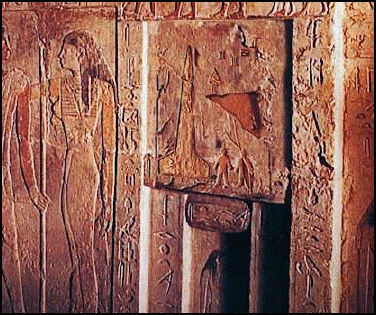
© Photo copyright Cosmic Conspiracies
The above wall mural resides in a temple in the goldmines of Kush. Notice the rocket and figures standing by it!
© Copyright Cosmic Conspiracies.
The first thing to note is that this time the exact location isn't given. We are told that this is found "in a temple in the goldmines of Kush." Kush, or Nubia, is a rather large area that includes southern Egypt and part of the Sudan (some of it is now submerged under Lake Nasser). We are also told that this relief is found in a temple. We may safely assume that it is a mortuary temple, associated with a tomb, because the architectural design is that of a false door. These were imitation doorways through which the soul of the deceased could pass in order to receive offerings of food and other goods. But trying to find this particular tomb in all of Nubia (the issue of "goldmines" aside) would prove a daunting task to the casual researcher. A more fruitful pursuit might be to closely examine the pictorial evidence without the advantage of further specific information.
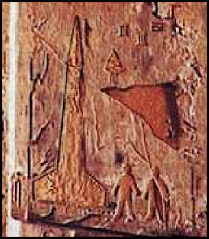
© Photo copyright Cosmic Conspiracies
Notice that the figures next to the "rocket" are shown frontally, unlike the other figures on this wall. The anatomical position of the figures is also very unusual, with the arms straight and to the side like gingerbread men. The figures themselves are without detail. Art in tombs tends to be very formal, and conventions are seldom flouted. There seems to be a problem with style where the figures are concerned.
Reliefs are carved into stone in two basic ways: raised and sunk. To produce a raised relief, the material is cut away from around a figure, so that the figure stands out from the matrix (surrounding background). A sunk relief is achieved when the body of the figure is cut into the matrix so that it is incised. Very often sunk reliefs were used on the outside of buildings so that the sun would cast sharp shadows in them for better definition. But sunk reliefs were also easier and quicker to sculpt, so they were sometimes used indoors as well.
A close examination of the larger photograph will reveal that the figures are in raised relief and the hieroglyphics are in sunk relief. Note the man's arm at the far right. The left edge is dark, in shadow, while the right edge is white (the source of light is to the right of the observer -- note the shadows at the bottom center). The glyphs, on the other hand, are dark on the right edge and light on the left, indicating that they are in sunk relief. Now look at the figures next to the "rocket." They are in sunk relief, unlike the other figures on the wall. They are inconsistent in several respects to the general style of the reliefs as a whole.
Modern graffiti (better described as vandalism) is universally executed in sunk relief, mainly because this method is fast and easy and it takes little talent or planning. It would not be illogical to conclude that the two small figures standing beside the "rocket" are products of modern vandalism. But what about the "rocket" itself? It is hard to tell if it is in sunk or raised relief; it almost looks outlined in black. The texture inside the outline is different than the texture surrounding the form, which is not truly vertical (nor does it share a baseline with the two "human" figures). The "rocket" looks as out of place as the two figures. If the purpose of the false door was to provide a portal for the spirit of the deceased to pass in order to receive offerings, then why would these figures appear here?
A critical examination of the evidence, while keeping in mind the context in which it appears, would lead the rational mind to discount unlikely theories of space alien intervention in favor of more prosaic interpretations. Ironically, the truth is always more interesting than falsehood, though some would discard the former in support of the latter.
Catchpenny Mysteries © copyright 2001 by Larry Orcutt.